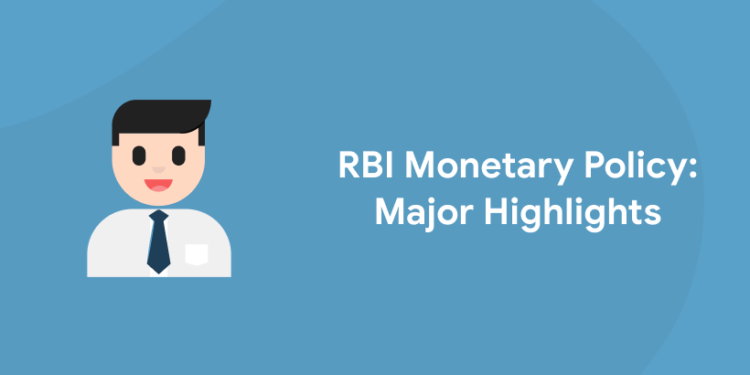Table of Contents
The monetary policy is formulated by the RBI (Reserve Bank of India). It discusses the monetary matters of the nation. It contains methods that are used to regulate the supply of money, availability and cost of credit in our economy. This policy also regulates the distribution of credit among the users and the borrowing and lending rates of the interest. For a developing nation like India, the monetary policy is essential for the promotion of economic growth.
Click here to find out more about the most recent SSC recruiting examinations.
Instruments of Monetary Policy
The instruments of monetary policy consist of
- variations in the bank rates
- other interest rates
- selective credit controls
- supply of currency
- variations in reserve requirements
- open market operations.
Click here to acquire the finest QA notes for the SSC recruitment exams in 2022.
RBI Monetary Policy: Major Highlights 2022
- Despite increasing inflation, the Reserve Bank of India (RBI) retained the benchmark interest rate at 4% and opted to maintain its accommodating posture.
- The Monetary Policy Committee (MPC), led by RBI Governor Shaktikanta Das, has kept the status quo for the 11th time in a row. On May 22, 2020, the RBI reduced its policy repo rate, or short-term lending rate, in an off-policy cycle to boost demand by decreasing the interest rate to a historic low.
Register for the top SSC coaching sessions to ace the tier 1 test.
- Now, two years after the epidemic, the global economy has seen tectonic upheavals, commencing on February 24th with the start of the war in Europe, followed by sanctions and growing geopolitical tensions
- The central bank said that the liquidity adjustment facility’s width will be restored to 50 basis points.
- Governor Das says the war might slow economic recovery, and the RBI has lowered its growth forecast for FY23 to 7.2 per cent.
Sign up to have access to the greatest resources for preparing for the 2022 SSC exam.
- The marginal standing facility (MSF) rate and the bank rate both remain at 4.25 per cent. Furthermore, the Reserve Bank has decided to restore the width of liquidity adjustment facilities, i.e. the LAF corridor, to 50 basis points, as it was before the epidemic.
- According to RBI Governor Das, global crude oil prices are still volatile.
- The RBI will work to preserve a stable financial market and will make efforts to mitigate the effects of global spillovers.
Register for the top coaching sessions to excel in the SSC reasoning part.
| Indicator | Current rate |
| CRR | 3% |
| SLR | 18.00% |
| Repo rate | 4.40% |
| Reverse repo rate | 3.75% |
| Marginal Standing facility rate | 4.65% |
| Bank Rate | 4.65% |
Grab the most recent short sample test series to pass the SSC recruitment exams in 2022.
Objectives of Monetary Policy
While the primary goal of monetary policy is to promote economic development as well as price and exchange rate stability, it can also help with other issues.
- Advancement of saving and investment: Because monetary policy governs interest rates and inflation within the country, it can influence people’s savings and investments. A higher rate of interest means more opportunities for investment and savings, which helps the economy maintain a healthy cash flow.
- Controlling imports and exports: Monetary policy assists export-oriented units in substituting imports and increasing exports by assisting industries in obtaining a loan at a lower interest rate. This, in turn, serves to enhance the state of the balance of payments.
- Business cycle management: A business cycle has two main phases: boom and depression. Monetary policy is the most powerful weapon for controlling business cycle booms and depression by regulating credit to manage the availability of money. Market inflation can be managed by lowering the quantity of money. On the other side, as the money supply expands, so does demand in the economy.
Grab the latest current affairs combined notes for SSC CGL and CHSL exams
- Aggregate demand regulation: Monetary policy may be employed by monetary authorities to keep a balance among both demand and supply of goods and services since it can affect demand in an economy. More individuals can get loans for the purchase of goods and services when credit is increased and interest rates are decreased. As a result, demand increases. When the government wants to limit demand, however, it can decrease credit and increase interest rates.
- Employment generation: Small and medium businesses (SMEs) can readily obtain a loan for company expansion since monetary policy can lower interest rates. This might result in more job possibilities.
Click here to get the best English grammar courses to qualify SSC recruitment exams
- Assisting with infrastructure development: The monetary policy provides for concessional finance for infrastructure development within the country.
- Giving priority segments more credit: Additional funds are given at reduced interest rates under the monetary policy for the development of priority sectors such as small-scale enterprises, agriculture, and underprivileged parts of society, among others.
- Managing and expanding the banking industry: The Reserve Bank of India oversees the entire banking industry. While the RBI wants to make banking services available across the country, it also orders other banks to open rural offices wherever they are needed for agricultural growth. In addition, the government has established regional rural banks and cooperative banks to assist farmers in receiving financial assistance quickly.
Click here to get the best English vocabulary courses to qualify SSC recruitment exams
All the major details and highlights of the monetary policy are discussed in the article. Download the entri app to attend general awareness and current affairs classes to ace the GK section of various competitive exams.











